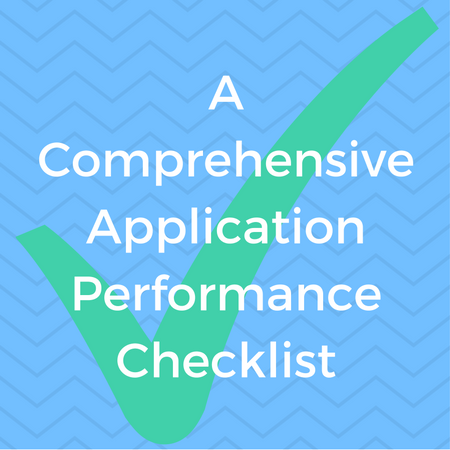The optimal performance of web applications and the networks that they are run on is vital to the success of your business.
Consequently, it is imperative that you manage, measure, and monitor these environments completely from the application, through the network, and finally to your end-users.
The ability to understand performance at each point and being capable of quickly rectifying any issue before it has an effect on your end-users is of paramount importance.
The ideal checklist will take into account six crucial areas to assess and monitor for efficient, expeditious application performance, as well as availability.
The application performance checklist outlined below will aid you in gaining insight, ensuring superior end-user experience, and creating seamless application delivery.
Constantly Trace Requests Through the Complete Application Stack
This involves following requests from process to process, measuring latency across the different networks, and following through the database and cache to the server.
Ideally this involves checking all work completed by the application, including detail at the code level.
Your reporting data should identify lagging queries, unanticipated cache misses, errors, and exceptions including:
- Performance data that has been consolidated from across an entire architecture.
- Web transactions that flow from a browser, to the load balancer, and through all services calls to the database.
- The tracking of all machines that are part of a transaction.
Perform an Assessment of Baseline Network Health
In order to be absolutely certain that your application is functioning at the highest performance level, a thorough understanding of the network it runs on is necessary.
This entails developing a baseline measure of network health and then meticulously monitoring network performance as a crucial component of your total application process.
The essential considerations include:
- Application and network visibility and transparency at every point from the end-user to the source, and back.
- Integrated snapshots of network diagnostics, application services, and metrics related to infrastructure.
- Tests to illustrate the quality of service for each path, and the assessing if applications that are performance-sensitive are ready.
- The views of application architecture, as well as the root causes of any issues.
- Bandwidth tracking, data loss, and latency between machines, data centers, and racks.
Real User Monitoring (RUM)
There is no denying the negative ramifications of lagging end-user page loads.
It's key to note that complete latency is determined by three primary components: the network, the browser that the client is using, and the servers that provide the data.
Performance problems can usually be traced to the server, while the vast majority of latency happens in the browser of the end-user.
Real user monitoring (RUM) will aid in:
- Monitoring user activity from its source -- the time that the client spends requesting and then receiving the page load.
- Observing the user’s web application based on geography or device used.
- Seeing the time that is spent waiting for the application to return results from the server and network.
- Understanding the end-user experiences which are tied to a specific server side.
Track Full Distributions of Crucial Metrics
It is vital to monitor specific application errors and exceptions, including any outliers.
It can also be helpful to record both the exception and also the flow of the request that created the exception.
The goal is to gather:
- Performance data that can be acted upon and resolved.
- Visual representations of request patterns, which should include spikes.
- Performance impacts that have a discernible trend.
- The source of any errors and exceptions in the application’s code -- and which values it had.
- A summary of errors that are collected according to type. This will allow for manageable browsing.
Monitor Synthetic User Experience
By creating synthetic user traffic, you can use this to test and also get a baseline for integral system elements when using new applications or executing changes.
It can also be helpful to analyze particular elements of a given application that include:
- Synthetic (created) traffic for specific transaction analysis of integral web application pages.
- Analyzing performances according to network, server, and browser.
- Allowing for continuous and uninterrupted monitoring of critical workflows.
- Showing detailed charts of page loads, transactions, and analysis of the network.
Seamlessly Integrate Performance Visibility
A performance tool, if it is to serve its intended purpose, should pinpoint problems at the end-user level.
Aside from that factor, the tool should ultimately allow visibility to work down and reach the proper level of the stack and rectify the issue at the root, regardless of where it started in the first place.
Quality performance tools should ideally be capable of tracking problems located in:
- Carrier networks that are located between the application and the end-user
- Database or cache services, which includes the business-oriented logic that determines the call
- The environment of the end-user, including the browser and the location
Top-of-the-line performance of web applications -- and the networks that they operate on -- is crucial to the success of your business.
Given that, developing and utilizing a thorough checklist to continuously monitor this performance is absolutely essential.
By following the above six steps, you can rest assured that your applications are operating at the best levels possible. 

